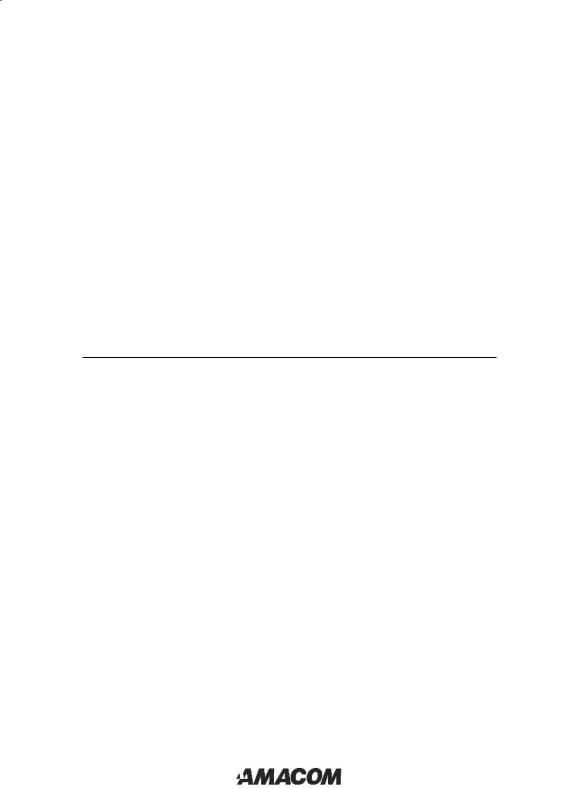
Rothwell W.J. - Beyond Training and Development[c] The Groundbreaking Classic on Human Performance Enhancement (2004)(2-e)(en)
.pdf
TLFeBOOK

BEYOND TRAINING
AND DEVELOPMENT
S E C O N D E D I T I O N
This page intentionally left blank

BEYOND TRAINING
AND DEVELOPMENT
S E C O N D E D I T I O N
The Groundbreaking Classic on
Human Performance Enhancement
William J. Rothwell
American Management Association
New York • Atlanta • Brussels • Boston • Chicago • Mexico City • San Francisco
Shanghai • Tokyo • Toronto • Washington, D.C.

Special discounts on bulk quantities of AMACOM books are available to corporations, professional associations, and other organizations. For details, contact Special Sales Department, AMACOM, a division of American Management Association, 1601 Broadway, New York, NY 10019.
Tel.: 212-903-8316. Fax: 212-903-8083. Web Site: www.amacombooks.org
This publication is designed to provide accurate and authoritative information in regard to the subject matter covered. It is sold with the understanding that the publisher is not engaged in rendering legal, accounting, or other professional service. If legal advice or other expert assistance is required, the services of a competent professional person should be sought.
Library of Congress Cataloging-in-Publication Data
Rothwell, William J.
Beyond training and development : the groundbreaking classic on human performance enhancement / William J. Rothwell.— 2nd ed.
p.cm.
Includes bibliographical references and index. ISBN 0-8144-0796-X
1. Performance technology. 2. Performance standards. I. Title.
HF5549.5.P37R68 2005 658.3 14—dc22
2004014341
2005 William J. Rothwell. All rights reserved.
Printed in the United States of America.
This publication may not be reproduced, stored in a retrieval system,
or transmitted in whole or in part,
in any form or by any means, electronic, mechanical, photocopying, recording, or otherwise, without the prior written permission of AMACOM, a division of American Management Association, 1601 Broadway, New York, NY 10019.
Printing number
10 |
9 |
8 |
7 |
6 |
5 |
4 |
3 |
2 |
1 |

T
, M V. R ,
( - ) , C S. R .
T .
This page intentionally left blank

C O N T E N T S
List of Exhibits |
xi |
Preface to the Second Edition |
xvii |
Sources of Information |
xvii |
The Scheme of This Book |
xviii |
What’s New in the Second Edition? |
xxiii |
Acknowledgments |
xxv |
Part One The Need to Move Beyond Training |
1 |
1. Why Training Is Not Enough |
3 |
Introductory Vignettes |
3 |
Problems with Traditional Approaches to Training |
5 |
Trends Affecting Organizations |
12 |
What Have Training and Development Professionals Historically Done? |
19 |
2. What Is Human Performance Enhancement? |
24 |
Performance Breakthroughs Are the Results of Human Choices, Not |
|
Technological Wizardry: A Case Study |
25 |
Defining Key Terms |
34 |
Important Propositions of HPE |
37 |
Key Models Governing HPE |
41 |
Introducing an HPE Model |
48 |
What Do HPE Professionals Do? |
50 |
What Are the Essential Competencies of HPE Professionals and Clients of |
|
HPE? |
51 |
Research on HPE |
55 |
Cross-Cultural Issues in HPE |
56 |
Ethical Issues in HPE |
60 |
3. Transforming a Training Department into a Human Performance |
|
Enhancement Department |
61 |
vii

viii |
CONTENTS |
How Organizations Should Support HPE: Key Success Factors |
64 |
Making the Case for Change |
65 |
Building Awareness of the Need for Change |
67 |
Building Awareness of Possible Directions for Change |
69 |
Assessing and Building Support for Change |
72 |
Creating a Flexible Road Map for Change |
75 |
Building Competencies Is Key to the Change Effort |
77 |
Communicating the Need for Change |
81 |
Training People to Think Like HPE Professionals |
82 |
Part Two Troubleshooting Human Performance |
|
Problems and Analyzing Human Performance |
|
Improvement Opportunities |
83 |
4. Analyzing What Is Happening |
85 |
What Does It Mean to Analyze What Is Happening? |
85 |
What Are the Roles of the HPE Consultant and Their Clients in Analyzing |
|
What Is Happening? |
89 |
What Prompted the Investigation? |
92 |
Gathering and Documenting Facts and Perceptions |
94 |
Analyzing Present Conditions |
98 |
The Competencies of the Auditor’s Role |
103 |
5. Envisioning What Should Be Happening |
105 |
What Does It Mean to Envision What Should Be Happening? |
106 |
What Are the Roles of the HPE Consultant and Their Clients in |
|
Envisioning What Should Be Happening? |
106 |
What Sources Provide Clues About What Should Be Happening? |
107 |
What Methods May Be Used to Collect Information About What Should |
|
Be Happening? |
116 |
The Competencies of the Visionary Role |
121 |
Part Three Finding Opportunities for Improving |
|
Human Performance |
123 |
6. Clarifying Present and Future Performance Gaps |
125 |
Defining a Performance Gap |
125 |
Identifying Performance Gaps |
128 |
Assessing Present and Future Performance Gaps |
135 |
The Competencies of the Gap Assessor Role |
135 |
7. Determining the Importance of Performance Gaps |
137 |
Defining Importance |
137 |
Assessing Consequences |
139 |
Who Determines Importance? |
141 |
Forecasting Importance |
143 |

Contents |
ix |
|
|
The Competencies of the HPE Facilitator |
144 |
|
The HPE Consultant’s Role in Determining the Importance of Performance |
|
|
Gaps |
148 |
8. |
Identifying the Underlying Causes of Performance Gaps |
149 |
|
Defining Cause |
149 |
|
Distinguishing a Cause from a Symptom |
151 |
|
Who Determines the Causes of Human Performance Gaps? |
154 |
|
When Should Causes Be Identified? |
154 |
|
What Is Known About the Causes of Human Performance Problems? |
155 |
|
Identifying the Causes of Human Performance Gaps |
162 |
|
How and Why Do Causes Change over Time? |
166 |
|
The Competencies of the Strategic Troubleshooter Role |
169 |
|
The Roles of the HPE Consultant and Their Clients in Identifying the |
|
|
Underlying Causes of Performance Gaps |
171 |
Part Four Selecting and Implementing HPE |
|
|
Strategies: Intervening for Change |
173 |
|
9. |
Selecting Human Performance Enhancement (HPE) Strategies |
175 |
|
What Is a Human Performance Enhancement Strategy? |
175 |
|
What Assumptions Guide the Selection of HPE Strategies? |
176 |
|
What Is the Range of Possible HPE Strategies? |
177 |
|
How Often Are HPE Strategies Used? |
177 |
|
How Should HPE Strategies Be Selected? |
186 |
|
The Competencies of the HPE Methods Specialist Role, the Forecaster of |
|
|
Consequences Role, and the Action Plan Facilitator Role |
189 |
|
What Are the Roles of the HPE Consultant and Their Clients in Selecting |
|
|
and Implementing HPE Strategies? |
192 |
10. |
Implementing Human Performance Enhancement Strategies to |
|
|
Address Organizational Environment Problems or Opportunities |
194 |
|
Who Are the Most Important External Stakeholders? |
195 |
|
How Well Is the Organization Interacting with the Most Important External |
|
|
Stakeholders? |
197 |
|
What HPE Strategies Can Improve the Organization’s Interactions with |
|
|
External Stakeholders? |
197 |
|
How Should HPE Strategies Be Implemented? |
206 |
|
The Competencies of the HPE Implementer |
207 |
11. |
Implementing Human Performance Enhancement Strategies to |
|
|
Address Work Environment Problems or Opportunities |
209 |
|
Formulating, Clarifying, and Communicating Organizational Policies and |
|
|
Procedures |
209 |
|
Enhancing Organizational Design |
214 |
